The Theory of Producing
Steam
Steam and water vapour are actually the same. The term 'Steam' is used more
along with the process application, whereas the term 'Vapour' or 'Vapor' is
the theoretically used general term for gaseous matter generated from
liquid (or solid) phase.
Water and steam are often used as
heat carriers in heating systems. It is known to everyone that water boils
and evaporates at 100°C at atmospheric pressure. And it is also common
knowledge for most, that when exposed to higher pressure, water evaporates
(and eventually condensates also) at corresponding higher
temperature.
This means that the water molecules are suppressed and
retained in liquid form by higher pressure, even when the molecules
increase their internal velocities and thus level of energy (by higher
temperature). For instance a pressure of 10 bar gauge (11 bar
absolute) equals an evaporation temperature of 184°C. These temperature /
pressure relations and other thermal properties appears from a so-called steam table
(see below pdf-file).
 AB&CO Steam Table
AB&CO Steam Table
During the evaporation (and condensation) process the pressure and temperature are
maintained constant (isobaric).
During this thermodynamic phase a substantial
amount of heat are use for bringing the water molecules in higher speed, and
thus from liquid phase to be released - a take-off into a kind of a
released "flying" vapour phase.
At this process the steam is "wet" in different degrees until all
water particles
are vaporised - and
the steam is then defined as in dry-saturated condition. It is just being 100% evaporated,
but not in a superheated condition (beyond evaporation temperature) as common known gaseous matter
are at
normal known temperatures (like for instance air and natural gas).
At this
point - the dry saturated condition - the steam
contains a huge amount of so-called latent heat, that corresponding the heat that was
provided during the
evaporation process. This heat correspond the energy of all the released
gaseous water molecules, moving at high velocities and thus with a high
content of energy.
If you heat the steam further from the dry saturated
condition (100% gaseous fluid) - then it becomes
- as previous mentioned - so-called superheated steam, and actually it
becomes an ordinary gas like air and gas, that can have any
temperatures independent of the pressure - and where heating just makes the
molecules moves faster and energy level increases, at same pressure
(isobaric).
In other words and in short, - despite temperature and pressure being constant in the
start and in the end of the evaporation (or condensing) i.e. for the liquid and the vapour
respectively, the amount of heat is very much higher in vapour
phase compare to the
liquid phase.
This retained and potential energy is called 'latent heat', and in the dry-saturated steam
(steam at boiling point) this thermal energy can efficiently be
utilised in
different applications for instance process heating.
Superheated steam
- on the other hand - is mainly used for high performance thermo-dynamic processes e.g.
to drive a steam turbines.
However slightly superheated steam is
often used in process heating in order to compensate for heat loss in steam
piping - and thus to ensure that the steam does not become wet but stay as
high quality dry saturated steam at the location where you need to use it.
Only boilers for saturated steam and steam heating systems are discussed in the following. Boilers
and systems for
superheated steam for other different thermo-dynamic applications is quite a
different subject that is covered by other literature.
The Steam Supply
In steam heating system, the steam boiler
(including the steam generator boiler) is connected to the consumers by
the steam and condensate piping. When the steam is applied to the
consumers, it condensates and thereby releases a high amount of latent heat
described above. The condensate (which is hot water) can then be returned to the feed water tank,
- from where it
again is pumped and provided as feed water to the steam boiler / steam generator. However sometimes the
steam is taken out of the system and consumed in an open system - for instance
when the steam is injected
into a product or in other way discharged or sprayed out (e.g. steam
cleaning or humidifying of air).
So in the closed system, the steam condensate is
returned to
the condensate tank and to the feed water tank respectively. Since steam
pressure in steam heating applications are normally quite high (beyond atmospheric pressure) a pressure reduction
in the form of a steam trap or orifice must be established at the condensate
outlet of the consumer(s) - i.e. before the condensate is eventually returned to the
feed water tank
(which are normally atmospheric or low pressurised) and the steam boiler.
Due to the above
discussed thermo-dynamic relations, this pressure drop causes a generation of flash steam - typically just after the steam trap(s) after the
consumer (whether it might be a heat exchanger or a vessel of any kind).
This gives the well-known large "condensate heat loss" in the steam system,
i.e. high-energy flash steam being generated and
quite noisy led into the condensate line and back to the atmospheric tank where is
steamed up into the ambient.
This mass loss of flash steam also represents corresponding physical and expensive loss of the feed water
content, which then requires
constant amount of fresh and pre-treated make-up feed water added to the circuit. The higher
the steam
pressure is, the higher the heat loss becomes (equals higher demand for expensive new
treated boiler feed water).
We are not speaking moderate losses, but losses between 10 and 30% - in both
heat energy loss and loss in expensive treated feed water ! This phenomenon is the huge disadvantage using steam
for heating - and today is is more or less required that you therefore
invest in flash steam heat recovery solutions when designing and adapting the steam
system into the relevant application processes.
The heat and feed water losses can not only be reduced, sometime its fully
eliminated by investing in "smart" heat recovery features, preferable
integrated in the complete heating system design.
Also other solutions can
minimise these losses, for instance free-circulation steam system,
where you utilise a static height and gravity in a self-controlled
evaporation-condensation-loop, but it can only be used in small and
quite tall systems on local spots - not large steam distribution systems.
The Steam Boiler Operation Principle
"Demand & Delivery"
Any steam boiler works in the principle the
same way.
A typical misunderstanding is that you control the production rate on a
steam boiler. This is not correct.
A steam boiler delivery exactly what is being
consumed in the system The steam boiler is always set for a specific steam
pressure, and the operation of the steam boiler is solely controlled by
means of this steam pressure set point.
The consumer in the system calls for steam by
the decreasing steam pressure since too much steam is condensed at the
consumers compared to what the steam boiler actually delivers.
The reduction
of steam pressure in the system is consequently detected by the control and
the pressure sensors in the steam boiler, which initialise heat (more heat)
in the boiler for evaporating more steam.
When sufficient steam flow
seems to be established, you will have a balance with the consumption of
steam (consumers of the system) and the steam pressure will return into a
stabile condition. |
When the consumers eventually stop demanding steam, the steam pressure
starts increasing - and this detected by the steam boiler control too, and
the heat for evaporating steam is then being turned down to a lower level
where the new balance will be established.
A steam boilers does not work like a machine. It does not impose steam to
the system, it only compensate the lack of steam that is being consumed by the
system.
A steam boiler is an autonomic device. It is purely self-controlled unit and
must thus never be manually controlled by others from safety reasons.
The Alternative to Steam
An
alternative to steam for heating purposes, to use a heat carrier
without evaporation and condensation. Most known is of course a conventional
hot water system. However fr industrial processes another more interesting
alternative is
HEAT TRANSFER FLUID (HTF) - a special
thermal oil where you can operate atmospheric (unpressurised) at
temperature above
300°C. This is however a complete different system, and you cannot just use
- or for that matter exposed - your existing steam system to another heat carrier like thermal oil.
You can
get more information on this subject using this link :
THERMAL
FLUID OIL VERSUS STEAM.
Steam Generator
Boiler
versus
Classic fire-tube Steam Boiler
THE PRINCIPLE IN THE FIRE-TUBE STEAM BOILER, is that from the surface of a large volume of feed water, steam
is evaporated. This boiling process is heated by the wall of the combustion
chamber (the radiant part) and by the exhaust gasses passing through a
bundle of so-called
fire-tubes or smoke-tubes forming the the convection part of the boiler.
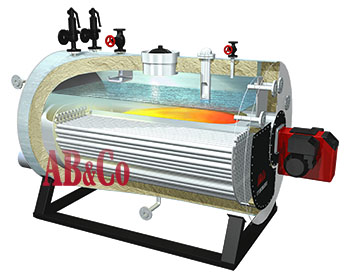

 |
Steam Boiler
Operation
AB&CO
animations
for PC and Smartphone |
In the so-called steam generator boiler the
operation is quite different. The feed water
and steam are in the principle passing through one long tube - designed as
a number of winded-up tube coils that are being serially connected.
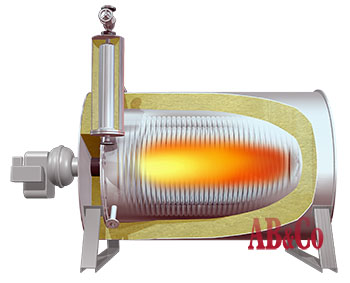
Horizontal or Vertical Design
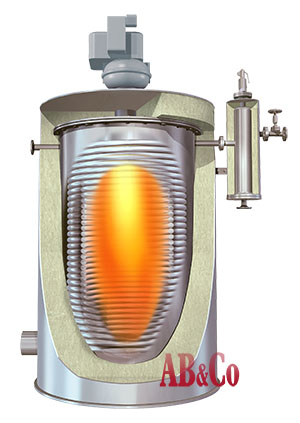
In this long tube of tube coil assembly, the feed water is heated up to the evaporation temperature
in the first part of the tube coil
and then evaporated in the second part. The intensity of the heat, the feed water flow and the size/length of
the tube are adapted, so that the water is just about being fully evaporated at the exit of the
tube. This ensures a very small total water and steam volume i.e. a small pressure vessel.
There are no extra volume of water at boiling point forming an
evaporation buffer in a steam generator, - and is the steam generator temporary overloaded beyond
its nominal steam capacity, it will gives a operation failure due and alarm
for high steam temperature (superheated steam). The solutions to prevent
this are often just to place a pressure sustaining valve in the steam
line. This valve will protect the steam generator against critically low
steam pressure due to uncontrolled high steam consumption beyond its max.
capacity. But another solution used is to install and connect a separate buffer tank next to the steam
generator that absorb a majority of steam pressure fluctuations (the demand
for extra steam buffer occur in about 10 - 15% of all installations). This
will give some of the advantages of the fire-tube steam boiler. The
ultimate alternative solution is of course to install a real fire-tube steam boiler
instead, - less sensitive to steam pressure
fluctuation (fluctuation is steam consumption).
The
Advantages using a steam generator compared to fire-tube steam boilers
are:
|
Steam Generator Delivery & Options
Steam generator boilers can be delivered in horizontal execution (with low
height), or in vertical execution (occupying limited floor
space). Like the fire-tube steam boilers they are delivered insulated with stainless steel cover
sheets and complete with burner, armatures, instrumentation, safeties and a control panel
- and with full documentation including necessary certificates.
The steam generator boilers are made with coils made
of seamless tubes, where the feed water is preheated and evaporated
during the flow through these. The heat is transferred to the
water/steam mixture as radiant heat in the combustion chamber, where
the inner cylindrical tube coil and a flat tube coil forms the
chamber wall and the bottom respectively. Consequently refractory
concrete at the end of the combustion chamber is avoided. The
combustion gasses are hereafter cooled in the outer convection part,
as the gasses pass the space between the two tube coils.
The thermal design of the steam generator ensures a modest volume of
steam relative to the size of the heater, and allows unlimited thermal expansion due to
the high temperatures. All steam generators and steam boilers must in Europe
be
designed and equipped according to European regulations including EU's
pressure equipment directive PED 2014/68/EU code and EN-standards for steam
boilers.
Electrical Heating - Option of the Future ?
Today there is an increasing demand for
ELECTRIC STEAM BOILERS. Particular the small sizes (up to 250 -
300 kg/h steam) are very popular. They are typically very price
competitive and very easy to install. No chimney and no fuel arrangement
- and very clean. They are today considered environmental
as electricity in many regions increasingly comes from non-fossil energy sources. But
often the electricity is both very expensive in consumption (kWh) since
price for distribution of electricity and taxes are still very high
worldwide. But also if a complete new larger size electrical supply must be establish
to obtain the requested steam capacity.
Rule of thumb is that each kg/h steam requires 1 Amp (@ 3 x 400V).
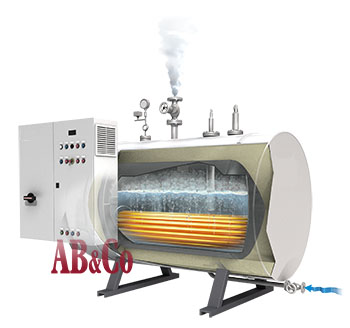
Electrical Steam Boiler - Industrial Design
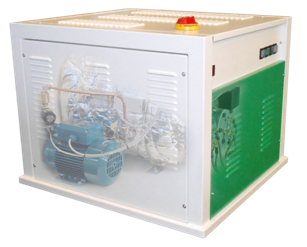
Electrical Steam Boiler - Commercial Design
Optional Steam
Boiler / Generator Design
Beside the standard execution the
steam generator boilers can be delivered in for instance following variations:
Exhaust Gas Steam Boilers
Steam can be produced
not only by oil/gas-fired burners and by electrically heating. The steam
boilers can
also be design as so-called recuperators utilising the
substantial amount of waste heat in for instance hot flue gasses or exhaust air. The
steam evaporation is done like the steam generators, and are gives
therefore a rapid acting and compact unit.
These are called
EXCHAUST GAS STEAM BOILERS (EGSB) or exhaust gas steam generator (EGSG).
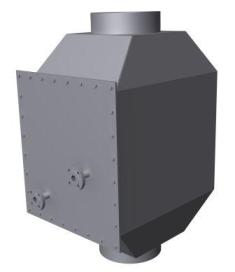
Economiser using up to 5 heat sources
and extractable / replaceable inserts
A heat exchanger utilisation the waste heat in flue gas of
the steam boiler or steam generator itself for increasing the boiler
efficiency, is called an
ECONOMISER. It can be used for preheating the feed water, but also for
external purposes including preheating of make-up water, domestic water or
central heating water.

|
Important Legal
Announcement
This article including all illustrations are
made by AB&CO and must be considered legally as property of AB&CO. It
can freely be referred to, but must not be copied in
parts or in whole without written permission by AB&CO Group.
Latest revision :
Copenhagen, 8th February 2021
by Arvid Blom,
Senior Engineer & Partner |


|






